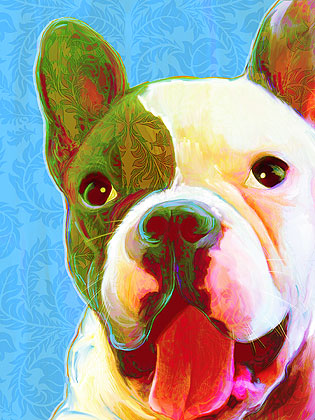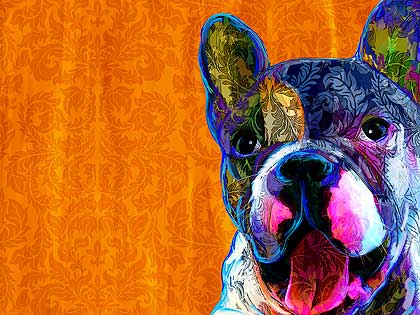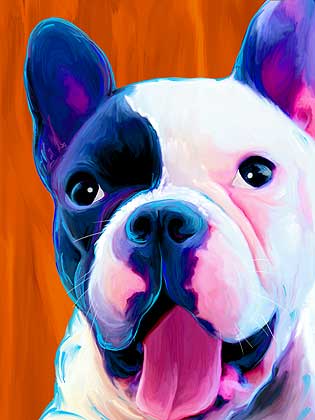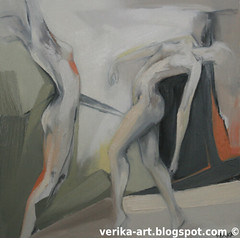Wednesday, October 31, 2007
Tuesday, October 30, 2007
Is "Talent" Overrated?

"Talent is cheaper than table salt. What separates the talented individual from the successful one is a lot of hard work". - Stephen King
Yesterday I started this post on "talent" and then I abandoned it because writing is not one of my natural talents. Today I decided what the heck, if the post is about talent being overrated then why not throw caution to the wind and toss this out there.
Sometimes I think talent is overrated. I am fortunate in that I have been told all my life that I am talented, and I have always had the ability to tap into my artistic talents to create and achieve things. I have heard "your so talented" since I was about 5 years of age and so I have always been a bit cavalier in my mind about talent as a commodity. I have never seen it as something that you can run out of someday, nor is it something to hoard or to dole out with a teaspoon. Talent "is", it just "is". I have it, and so do millions of other people I see on the web and in the world.
When it comes to talent and earning a living it is my opinion that talent is only a thing of value if you also have a kick-ass work ethic to go along with it. Talent will serve you well only if you have faith in yourself as a well rounded person with brains and skills beyond your obvious "god given" talents. I believe talent will always take a backseat to passion and that the most talented artist on the planet will never earn a dime with their artwork if they are not passionate about their work. So yea, I would have to say that in general talent is overrated. You should value your talents and nurture them, however never work under the false assumption that your unique talent is going to make you special or make you stand out. Your unique talents are only one tiny piece of who you are are and what you have to give to the world.
Friday, October 26, 2007
German Shepherd Portrait
Thursday, October 25, 2007
Wednesday, October 24, 2007
French Bulldog Art With Pattern
Tuesday, October 23, 2007
Art Paw On TV!
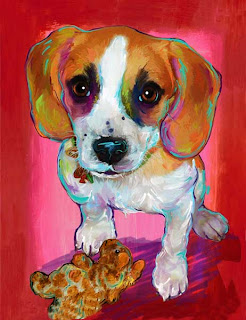
Our artwork is going to be featured today on TV in Houston. Art Paw was contacted to create a special portrait for Great Day Houston's show host Whitney Casey's little pup Nolita. We are thrilled for the exposure and very happy with how this fun little Beagle portrait turned out. I'll be sure and post a link to the episode once it is on-line.
Sunday, October 21, 2007
Saturday, October 20, 2007
A note on the artist, her art and what she is allowed to say about it

(Thank you for the patience, the comments, the e-mails and links. I appreciate it all.)



Should we resist the myth of an art without a context?
Doris Solcedo's Shibboleth at Tate's Turbine Hall has sparked controversy for an unusual reason: one blogger found her work to be much better than what the artist had to say about it:
There is little in the world of art more deflating (...) than hearing an artist tell you what a work represents.Considering the way Solcedo appears to have been talking about the work, it seems only fair to consider it a turn-off. You get this huge, rich piece, and a comment, a perspective that seems simply poor. One begins to wonder if it's really worth all the fuss. After all, it's a difficult exercise to go back from the work to the idea that
Doris Salcedo would like you to know that a crack in the floor represents borders, the experience of immigrants and the experience of racial hatred. She would also like you to know that racism is bad and that Europeans are bad for being racist.
However, I wouldn't give up on Doris that quickly. For several reasons.
For one, every artist has the right to think of his work what he wishes. And if the work surges from a need to fight racism, then be it. Many a brilliant work of art has been made through a very local inspiration. Why should she censor herself when speaking about it, then? Oftentimes, we can hardly agree with the artist's point of view, and from time to time the artist herself criticizes her standpoint after a certain lapse of time. But this does not necessarily discredit the work. Rather, it shows how the very limitations of an artist can participate in the creation of wonderful works (for some extreme examples, think of Leni Riefenstahl or the Soviet constructivists).
The artist's work is the artist's work. This is not as always as obvious as it might seem, given the various avantgarde adventures into questioning the work as work and/or the artist as the artist, on one hand, and the value the art market seems to give to the meta-work level, on the other. Still, we are free to go back to the work. To the object, the sign, the gesture, the mark. To what we consider of relevance. The work is there to be eaten up, to be devoured no matter what it takes. If we need to abandon the artist to do it, so be it.
I re-read what I have just written, and I don't always agree with it. The principle is fine, but in practice things aren't as simple. How can I forget what I hear, what I read, what I see? Whatever the context, it is present. And the less we get from the work, the more we are bound to bind ourselves to what is around it. Which is why a conceptual work is so difficult to isolate from its references. And why a crack can be so many things.
But here are two other points:
//considering we do listen to the artist, even if we don't want to, let us first go and see the title up. A 'shibboleth' is a custom, phrase or use of language that acts as a test of belonging to a particular social group or class. To someone attentive to the context, this can very well be a guide. You might consider it too narrow already, too restraining and bluntly political, but then again, you might just embrace it as a proposed "appreciation reference". And then, it's a new game, isn't it?
//why does a crack need to be so many things? What is this constant necessity we, artists, feel to not say what something is to us? Of course, it can be more than anything in particular. And we don't want to ruin the experience for the spectator. But then again, it might just come out of a particular urge, question, opinion. What is so unacceptable about admitting that? Does every (good) work of art need to have a hundred possibilities, and does its creator need to embrace them all? Mind you, we are not in the zone of imposed lectures any more, only, maybe, of an honest artist's statement that gets to the point: this is what I had in mind.
Another issue comes to mind. Considering we do accept the artist's "pragmatic" and political point of view, and see it as (I'll dare and use the word) a metaphor of a socially unfair world, what are we left with? What are we supposed to do about it? Will this act change a single thing? What sort of conscience do we develop through these marvelous poetic politics? Or does it chiefly bring us closer to the appreciation of our total incapacity to do anything about what we see? Can this despair be fruitful? And what can this fruit actually be?
Yogi The Boxer
On this piece we sat down together and discussed the original photograph for about 15 minutes. I asked Al to create more ear on the right and to place in an extra paw. Yogi is adorable and yet I thought that the original pose made this pup look just a wee bit sad. By perking up that ear on the right and adding in another playful paw I was hoping to lighten the mood a tad.
The image below was created by Allison, using the smudge tool. She has a wonderfully soft approach to the wacom and her technique is lovely. She never adds color with the paint brush or finger-painting tool however she is totally the queen around here with the smudge tool. You can see that addressing the glow eye , ears and paws have really perked this pup up. You can click images for larger versions.
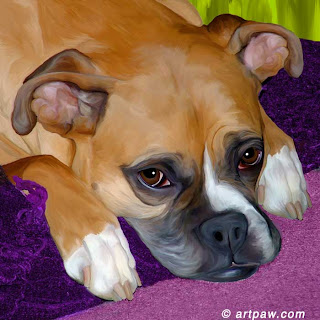 Below you will see where I have started to play and have added some more color and bolder strokes here and there. You see it most around the ears, snout and paws. I like to have strong jabby-strokes and some visible line work present in most of my work.
Below you will see where I have started to play and have added some more color and bolder strokes here and there. You see it most around the ears, snout and paws. I like to have strong jabby-strokes and some visible line work present in most of my work.
The image below is my favorite and the one the client picked. Here I rotated this girl and erased some blanket to free up that ear on the right. By rotating her I created a much more playful pose. I used the posterize filter on this at a low opacity and then went in with some loose line-work on top using the wacom. The color is really starting to pop here.
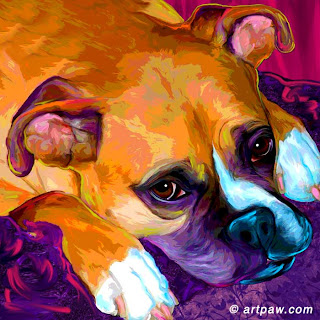
Below I decided to just push it to a wild extreme and colorized the heck out of this girl playing with a halftone pattern along the way. This is not my favorite, but a fun option.
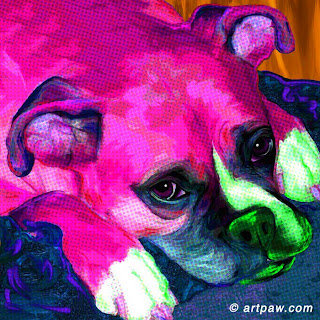 You can see in the small thumbnails below that composition is everything and it is important to not let your original pose or photograph limit you. I find that composition is the hardest thing to teach, and that too often new digital artists will limit themselves by the reality of the photo in front of them.
You can see in the small thumbnails below that composition is everything and it is important to not let your original pose or photograph limit you. I find that composition is the hardest thing to teach, and that too often new digital artists will limit themselves by the reality of the photo in front of them.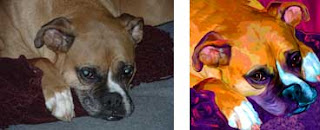
By working as a team on projects we end up putting in a lot of time on every piece and the creative ideas and sharing of skills have been making us all much stronger.
Friday, October 19, 2007
Avidly growing an editor's network
Hordylan is the new president of the 12-year-old 700-member Avid Toronto Users' Group (replacing the group's founder Al Mitchell), and he's keen to put the perfect spin on the technology. "Everyone I know in the industry has one," boasts Hordylan. "You never have a problem with Avid."
Hordylan's message comes across as pure PR (as Avid is celebrating its 20th anniversary this year), but as the new leader of the non-profit association, his top priority is actually to create a much-needed directory and database of editors in a revamped ATUG website.
"I've noticed the difficulties production and post-production facilities have had finding freelance editors," says Hordylan. "My hope is that through the website, the frustrations of companies looking for editors will end."
Avid Technology is fully supporting the project and has promised Hordylan that the site will be up before 2008. The directory will offer every ATUG member one free demo and CV page and the site will also feature job postings and a forum.
Hordylan says the invigorated group will also increase the scope and variety of its seminars - which typically attract about 80 participants - adding sessions that underline "what editing really is - an art form."
On Oct. 25, at the Bravo! studio in the former CHUM/City Building on Queen Street, ATUG will present a panel on editing dramas and comedies.
Eric Abboud, who has worked on Bravo!'s Arts and Minds, will host, and one panelist, The Tudors' editor Lisa Grootenboer, has been confirmed to participate.
Another more technology-based session dealing with intra-frame editing, advanced motion effects, vector-based graphics and advanced key framing is expected to take place in late November.
Hordylan notes that ATUG founder Mitchell started the first Avid user group in the world and that chapters now exist in the Middle East, Japan and the U.S.
Me & Tommy at the Beach
Wednesday, October 17, 2007
Pet Magazine Cover Art

We just returned from a quick trip to the beach yesterday. We left on Friday and took the Scotties so the blog will be full of doggy pics in the ocean very soon. Today I am posting a magazine cover we did for the Chicagoland Tails Magazine. I worked on this artwork way back in the spring and so it is exciting to see it come to life. Their designer did a great job with the aqua font and groovy floral touches on the text place holder at the bottom right. We are thrilled for the exposure in Chicago and have even had a few calls already. Our thanks go out to Natalie for contacting us with this great opportunity.
Monday, October 15, 2007
Producing creative drawings with Live Trace and Live Paint
Producing a creative drawing on paper tends to be a two stage process involving “inking” and “colouring”: sketching the defining lines in black and then filling this framework with colour. The first mainstream program to attempt to translate creative drawing to a computer environment was Adobe Illustrator back in 1987. Based on Adobe’s PostScript technology, Illustrator and subsequent competitors such as CorelDRAW and Macromedia FreeHand build their drawings as mathematically-defined vectors or “paths”. “Stroking” an open-ended path produces a line and filling a closed path produces a coloured shape. And with a stack of stroked and/or filled paths you have all you need to reproduce any illustration – or technical drawing, graphic design or even text-based layout. It’s a beautifully efficient system and one that has become second nature to generations of computer artists.
Second nature maybe, but no-one could say that drawing with vectors is truly natural. Compared to the simple creative freedom of sketching on paper, the whole process of drawing onscreen is intrinsically awkward and indirect despite important advances such as freehand tools and digitizing tablets. And there are further limitations imposed by the underlying vector architecture. For creative drawing, you often want lines that are fluid and expressive, but that’s just not possible with stroked paths which are intrinsically uniform along their length. Again advances such as vector brushes that treat each stroke as a filled path radically improve the end results – Creature House’s Expression deserves especial credit here - but no-one could claim they were as natural as pens and pencils.
by www.designer-info.com veiw full Article
Monday, October 8, 2007
Flowers Everywhere Wallpaper
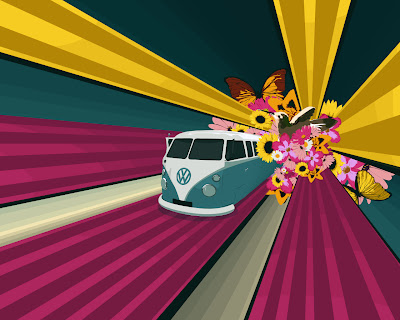
Sunday, October 7, 2007
Chloe The Yellow Lab
 Soft Painterly style with solid green background in image above. Below I added in a low opacity brick wall with abstract flowers painted on it. The textural grunge quality of the brick wall below gives the piece a very urban feel.
Soft Painterly style with solid green background in image above. Below I added in a low opacity brick wall with abstract flowers painted on it. The textural grunge quality of the brick wall below gives the piece a very urban feel.
Below I slammed on a posterize filter and increased the hue saturation. I then painted a loose black out-line around the subject and added a red tennis ball so that Chloe's stash of hoarded toys would be larger. The filter and black lines serve to flatten the piece a bit making it more graphic and stylized. This is one of my favorite proofs. I love the color.
 Remembering that the client wanted soft subtle color, I desaturated Chloe a bit here and gave her a blue wall.
Remembering that the client wanted soft subtle color, I desaturated Chloe a bit here and gave her a blue wall. Below I used a conte sketch filter in blue & yellow then played with the opacity of that layer over the original layers. The effect is cool and would make a great illustration for a magazine.
Below I used a conte sketch filter in blue & yellow then played with the opacity of that layer over the original layers. The effect is cool and would make a great illustration for a magazine.
Saturday, October 6, 2007
 Part of the Decampment series by the now 16-year-old photographer Megan Baker.
Part of the Decampment series by the now 16-year-old photographer Megan Baker.What I like most about this picture is the grayness.
Friday, October 5, 2007
Tuesday, October 2, 2007
Dancing in Olive Green Fields
Dancing in Olive green fields.



